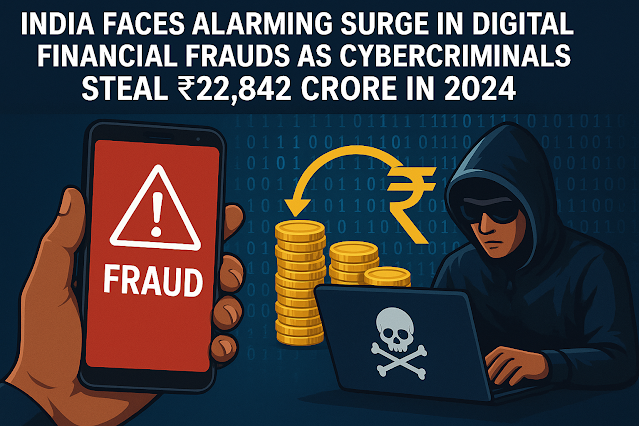KalimNews | August 1, 2025 | New Delhi : India’s digital economy, which has rapidly expanded over the past decade, now finds itself battling a parallel and deeply entrenched cybercrime crisis. According to a recent report by DataLEADS, a Delhi-based media and technology firm, digital financial frauds in India reached a staggering ₹22,842 crore in 2024—nearly triple the ₹7,465 crore reported in 2023 and almost ten times the ₹2,306 crore recorded in 2022. The report, titled “Contours of Cybercrime: Persistent and Emerging Risk of Online Financial Frauds and Deepfakes in India”, highlights a grim trajectory of escalating cybercrime in the country.
The Indian Cybercrime Coordination Centre (I4C), a federal agency under the Ministry of Home Affairs, has warned that if the current trend remains unchecked, cybercriminals may siphon off over ₹1.2 lakh crore in 2025. The scale, reach, and sophistication of these operations have rapidly evolved, posing serious threats across sectors—ranging from banking and insurance to retail, healthcare, and public investment schemes.
The report noted that more than 20 lakh cybercrime complaints were filed in 2024, a nearly 30% increase from the year before and a tenfold surge since 2019. This sharp uptick has paralleled India’s dramatic growth in digital financial activity, with over 190 crore Unified Payments Interface (UPI) transactions conducted in June 2025 alone, valued at ₹24.03 lakh crore. With India now accounting for nearly half of all digital transactions globally, its increasingly connected population has become a prime target for digital fraud.
The roots of this crisis, the report suggests, lie in both the scale of digital adoption and the vulnerabilities that have come with it. The post-pandemic digital push—intended to enhance financial inclusion, especially in rural areas—brought hundreds of millions online. By 2019, India had over 440 million smartphone users and some of the world’s lowest data costs, with 1 GB priced under ₹200. As smartphones and internet access penetrated deeper into rural belts, more people began managing finances via digital platforms, often with limited cybersecurity awareness.
Unfortunately, this shift has also empowered a sprawling ecosystem of cybercriminals. Many, driven by financial desperation in a country with nearly 290 lakh unemployed individuals, have been drawn into fraud networks. These syndicates now employ advanced technologies—including Artificial Intelligence and deepfake videos—to impersonate trusted public figures and institutions, further complicating enforcement efforts.
Banking fraud has emerged as one of the most alarming areas of concern. The Reserve Bank of India (RBI) reported that financial frauds in the banking sector surged nearly eightfold, from ₹2,623 crore in the first half of FY 2024–25 to ₹21,367 crore during the same period in FY 2025–26. Private banks accounted for nearly 60% of reported fraud cases, but it was customers of public sector banks who suffered the most, collectively losing ₹25,667 crore.
Insurance frauds have also risen sharply. Cybercriminals are increasingly impersonating agents from reputed companies such as HDFC, Royal Sundaram, Kotak, and Shriram Insurance. They reach potential victims via WhatsApp and Telegram, using official-looking logos and communication formats to gain trust before soliciting payments for fake policies or services.
Investment scams have become another area of concern, often targeting educated individuals with promises of high returns. Victims are lured through persuasive communication and fake platforms, often losing large sums of money before realising the deceit. These schemes, the report notes, prey not just on greed but also on financial insecurity, especially among younger, educated job seekers.
Phishing messages, fake payment confirmation links, and fraudulent e-commerce listings are among the most common tools in the cybercriminal playbook. Victims are often tricked into revealing sensitive financial information or installing malware on their devices through seemingly innocuous links shared via SMS or popular messaging platforms.
WhatsApp has emerged as a major hub for financial fraud. I4C data shows over 15,000 finance-related cybercrime complaints were recorded via WhatsApp in January 2024 alone, with similar numbers reported in February and March. Telegram, Facebook, Instagram, and YouTube have also been flagged for widespread misuse in such scams.
Despite their significant role in facilitating these interactions, technology companies have continued to position themselves as “platforms” rather than “publishers,” allowing them to sidestep liability for user-generated content. Meanwhile, content moderation and fact-checking efforts have declined across many of these platforms, reducing their effectiveness in curbing harmful content and fraud.
While the government has passed legislation to increase accountability and transparency from these tech firms, experts argue that existing laws remain inadequate. Stronger enforcement mechanisms, robust transparency standards, and widespread public awareness campaigns on cyber hygiene are urgently needed to combat the growing cybercrime menace.
As India continues to lead the world in digital payments and online transactions, it now faces the dual challenge of maintaining digital growth while ensuring that its citizens are protected from fraud. Without immediate, coordinated action between law enforcement, policymakers, financial institutions, and technology platforms, the digital gains of the past decade may be severely undermined by the unchecked rise of cybercrime.









